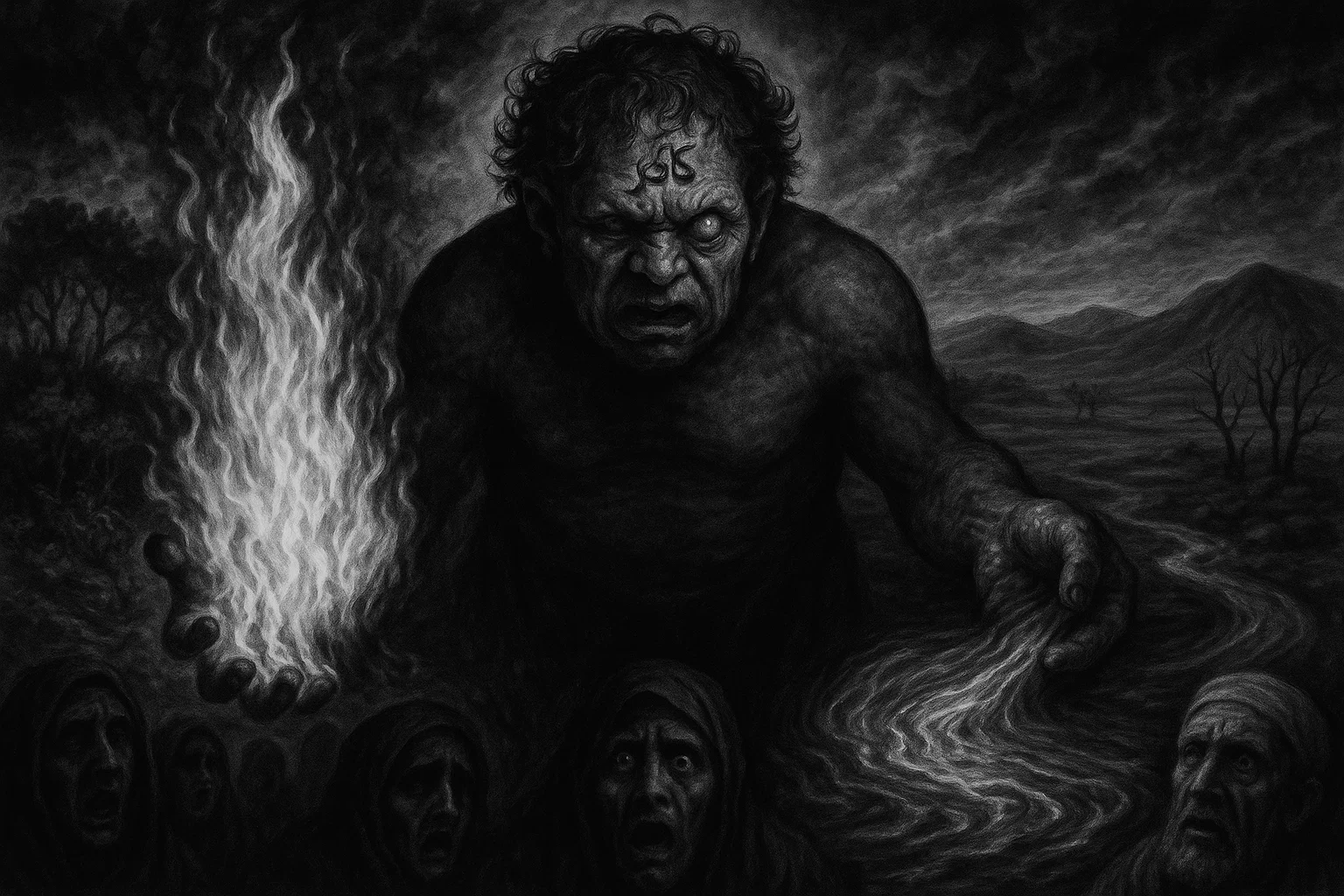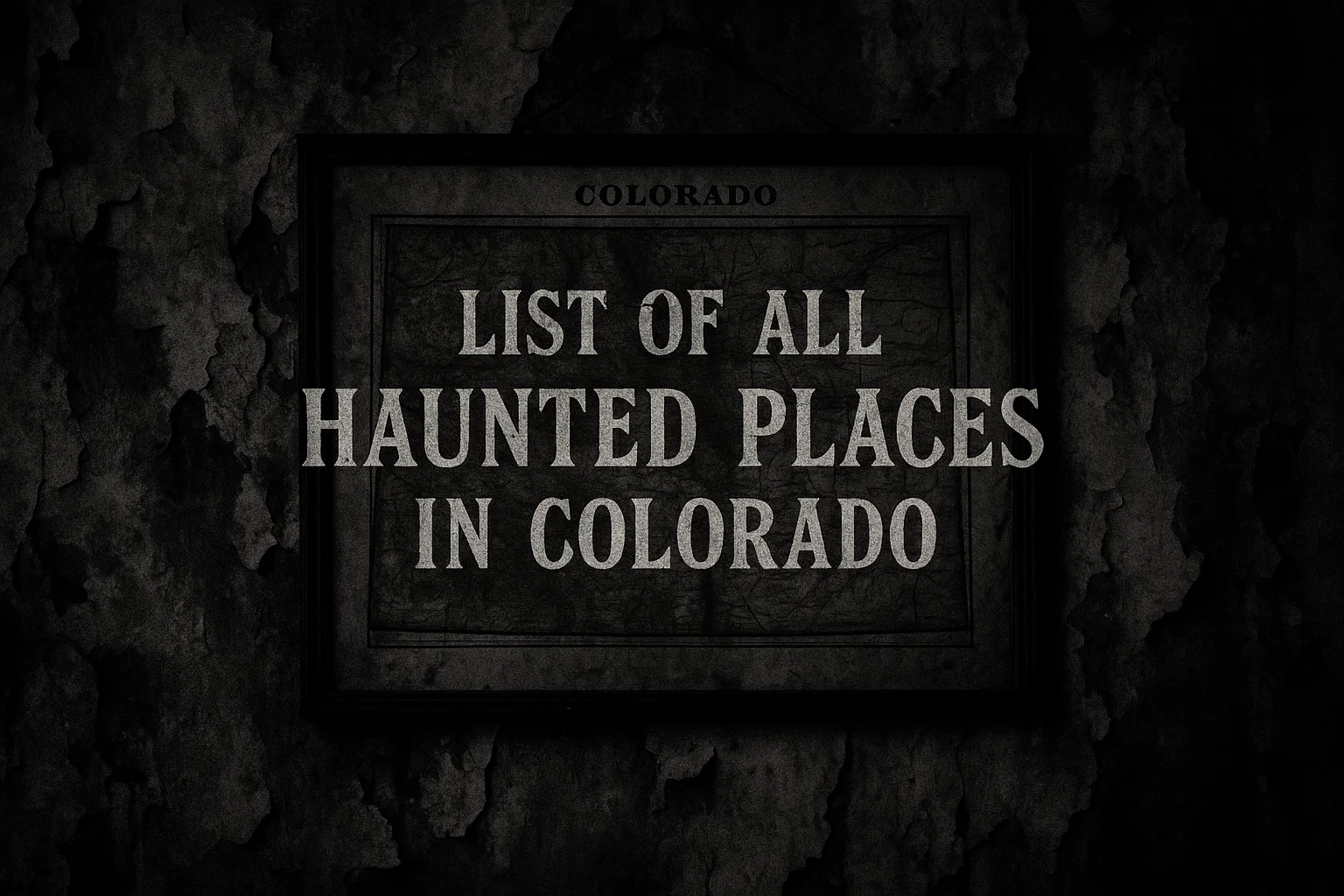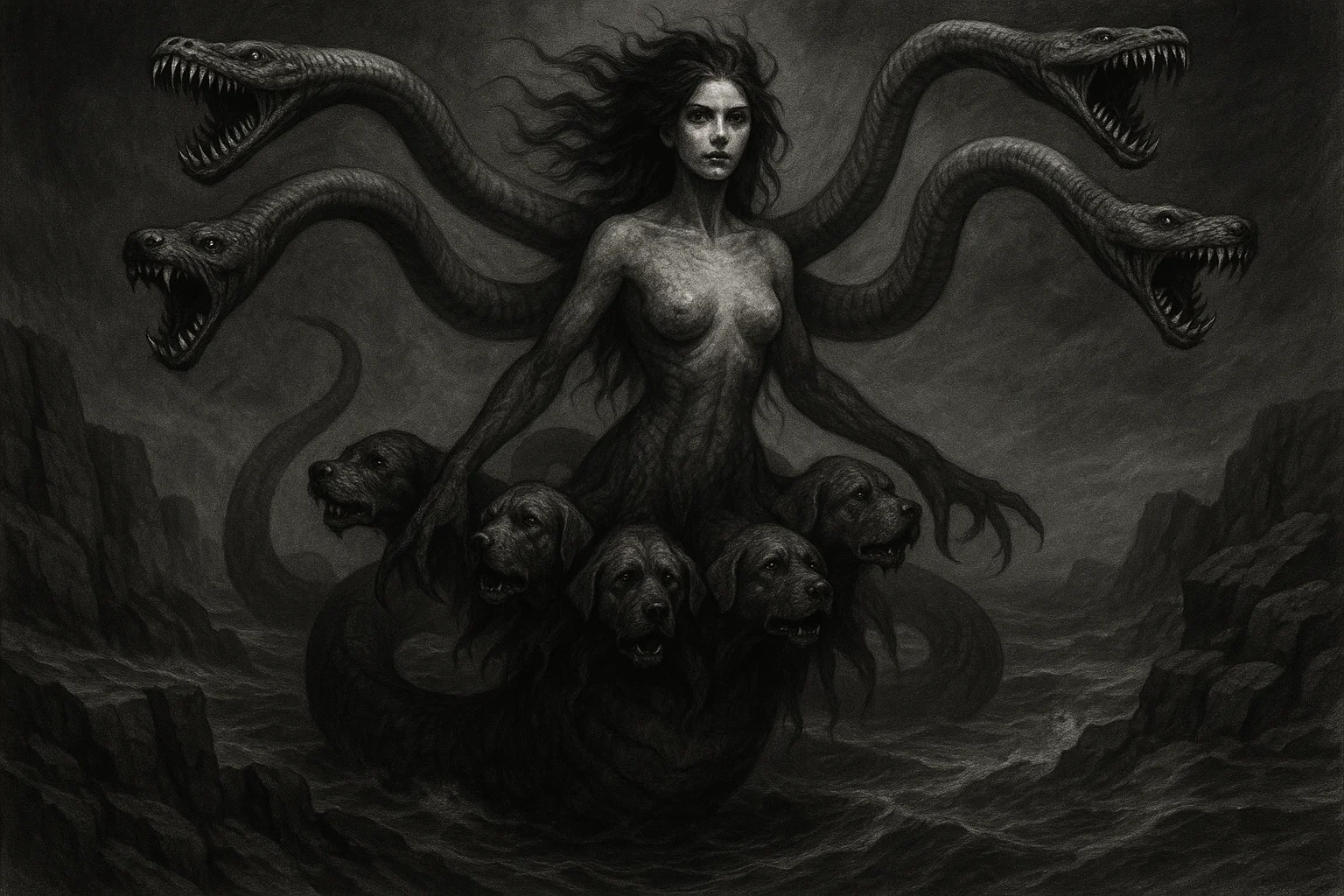Dajjal is a harbinger of unparalleled deception. Known as Al-Masih ad-Dajjal, or the False Messiah, he embodies the ultimate test of faith, weaving illusions that blur the line between divine truth and satanic deception. This enigmatic entity, whispered about in ancient Hadith collections, promises a reign of chaos that tests humanity’s resolve, drawing the faithful into a web of wonders and woes.
Yet, the tale of Dajjal is no mere myth of doom; it is a profound cautionary narrative, rooted in the prophetic warnings of Muhammad, peace be upon him. As global uncertainties mount, searches for “Dajjal in Islam” and “Dajjal end times” surge, reflecting a timeless quest to decipher signs of the apocalypse.
Through his story, believers confront the fragility of certainty, urging vigilance against the subtle corruptions that prelude greater tribulations.
Summary
Key Information
| Category | Details |
|---|---|
| Name | Performs deceptive miracles mimicking Isa: healing the sick, raising the dead (via demons), commanding rain and vegetation growth, stopping the sun, creating an illusory paradise and hell (reversed: his hell is cool water, paradise is fire), rapid travel like wind-driven clouds, and commanding treasures to follow him. |
| Title | The greatest liar; the messiah of misguidance; the one-eyed Antichrist figure in Islamic eschatology. |
| Gender | Male. |
| Role | Antagonistic deceiver who impersonates the true Messiah (Isa/Jesus), claims divinity, performs false miracles to lead humanity astray before the Day of Judgment, and serves as the ultimate test of faith (fitnah). |
| Hierarchy | Short, stout, ruddy-complexioned young man with curly hair, broad forehead and chest; blind or defective in one eye (right or left, resembling a floating grape); “kafir” (disbeliever) written between his eyes, visible to all Muslims, literate or not; pigeon-toed, hunchbacked in some descriptions. |
| Servitors | An army of devils (shayatin) who aid in miracles like raising the dead; seventy thousand Jews from Isfahan wearing Persian shawls; Bedouins, weavers, magicians, children of fornication, women, and hypocrites drawn to his illusions. |
| Superior Demon | None specified; his powers are granted by Allah as a test, not from a demonic overlord, though influenced by Iblis (Satan) in broader eschatological narratives. |
| Powers | Short, stout, ruddy-complexioned young man with curly hair, broad forehead and chest; blind or defective in one eye (right or left, resembling a floating grape); “kafir” (disbeliever) written between his eyes, visible to all Muslims, literate or not; pigeon-toed, hunchbacked in some descriptions. |
| Appearance | Short, stout, ruddy-complexioned young man with curly hair, broad forehead and chest; blind or defective in one eye (right or left, resembling a floating grape); “kafir” (disbeliever) written between his eyes, visible to all Muslims literate or not; pigeon-toed, hunchbacked in some descriptions. |
| Etymology | From Arabic root d-j-l (“to deceive” or “lie”); superlative form meaning “great deceiver”; linked to Syriac “daggal” (false, spurious); “Masih” means anointed one or messiah, contrasting the true Masih (Isa). |
| Associated Figures | Isa (Jesus, who kills him); the Mahdi (rightly guided leader who precedes and aids in his defeat); Tamim al-Dari (early witness in Hadith); Ka’b al-Ahbar (Jewish convert influencing narratives); Yajuj and Majuj (Gog and Magog, following his defeat). |
| Weaknesses | Cannot enter Makkah or Madinah (guarded by angels); powerless against true faith (e.g., fails to kill a resurrected believer twice); killed by a glance or spear from Isa at the gate of Ludd; recitation of Surat al-Kahf’s opening or closing verses repels him. |
| Opposing Angel/Saint | Isa ibn Maryam (Jesus, the prophet and true Messiah); angels guarding holy cities; the Mahdi as a human counterpart. |
| Equipment/Tools | A deceptive “paradise” and “hell” (rivers of fire/water, lush gardens of torment); a staff or spear for miracles; illusory treasures and demons as aides; no specific weapon, but commands nature and death. |
| Pantheon | Islamic eschatology (not a polytheistic pantheon); part of Abrahamic traditions, adapted from Christian Antichrist and Jewish anti-Messiah figures into Sunni and Shia end-times lore. |
Etymology
The name Dajjal derives from the Arabic root d-j-l, which fundamentally conveys notions of deception, falsehood, and obfuscation. At its core, dajala means “to mix truth with lies” or “to coat something inferior with a veneer of value,” evoking the image of gilding base metal to mimic gold. This linguistic foundation captures the essence of Dajjal as a master impostor, one who veils reality in alluring illusions to ensnare the unwary.
Scholars trace deeper layers to Syriac influences, where daggal (ܕܓܠ) signifies “false” or “spurious,” suggesting early Christian apocalyptic borrowings during Islam’s formative centuries.
In classical lexicons like Lisan al-Arab, Dajjal is the intensive form, implying an extreme deceiver who not only lies but defiles truth itself—dajal as “defiler” or dojjala as “refuse of humanity,” extending to his followers as societal dregs. The prefix al-Masih (the anointed one) juxtaposes him against Isa, the true Messiah, highlighting his blasphemous parody.
This etymological richness underscores the Dajjal’s role in eschatology: a linguistic trap that mirrors his deeds. As Ibn Manzur notes in Lisan al-Arab, the term evokes covering the earth in sin, much like Dajjal‘s prophesied global sway.
In Hadith, such as Sahih Muslim 2933c, the Prophet Muhammad, peace be upon him, spells “k-a-f-i-r” on his forehead, tying the name’s deceit to overt unbelief. Over centuries, Persian and Turkish glosses amplified this, portraying Dajjal as a “one-eyed liar” whose very utterance conjures dread, blending Semitic roots with Indo-Iranian apocalyptic motifs.
Early transmitters, such as Ka’b al-Ahbar, a Jewish convert, infused Hebrew echoes—dajjal, akin to meshuggah (meaning “mad deceiver”)—bridging Abrahamic traditions. By the Abbasid era, as in al-Tabari’s Tafsir, the name symbolized spiritual blindness, the defective eye mirroring obscured divine insight.
You May Also Like: The Demon Div: The Terrifying Horned Demon of Chaos
What Does Dajjal Look Like?
The physical form of Dajjal is etched in vivid detail across Hadith, designed not just for recognition but as a divine marker of his falsity.
He appears as a stout, short young man, ruddy of complexion like sun-baked earth, with thick, curly hair cascading wildly and a broad forehead that seems to strain against hidden thoughts. His upper chest is expansive yet slightly sunken, evoking a false grandeur, while his legs are pigeon-toed, hinting at an unsteady path.
Central to his visage is the defective eye—often the right, resembling a bulging, floating grape, blind and useless, neither protruding nor recessed.
Some narrations shift it to the left, covered in thick flesh, but both underscore imperfection: a symbol of spiritual myopia, unable to perceive Allah’s unity. Between his eyes, in bold Arabic script, gleams “kafir”—disbeliever—etched by divine will, legible to every Muslim, literate or not, as if Allah unveils the lie for the faithful alone.
In one Hadith vision from Sahih Bukhari 1882, he circles the Ka’bah, hands on shoulders, his form a grotesque mimicry of pilgrimage. Hunchbacked in whispers from Ahmad’s Musnad, he shuffles with deceptive poise, his green left eye gleaming like a false emerald amid ruin.
These traits, far from monstrous, are disarmingly human—plump and approachable—to lure the naive, contrasting Isa’s balanced grace. As al-Nawawi explains in Sharh Sahih Muslim, this ordinariness amplifies the trial: Dajjal‘s allure lies in seeming savior-like, until faith pierces the veil.
Historical and Mythological Background
The narratives of Dajjal weave through Islamic lore as a tapestry of warnings, emerging not from the Quran but from Hadith clusters compiled in the 8th and 9th centuries.
These stories, adapted from Syriac Christian apocalypses and Jewish anti-Messiah tales, portray him as a harbinger of fitnah, his emergence tied to cosmic unraveling. Early transmitters like Naim ibn Hammad in Kitab al-Fitan (c. 843 CE) framed Dajjal as a post-tribulation tyrant, his chains rattling in Eastern folklore until famine unleashes him.
The Encounter of Tamim al-Dari
One foundational legend, narrated in Sahih Muslim 2942a by Fatimah bint Qays, recounts the story of Tamim al-Dari’s shipwreck on a remote island.
Amid stormy seas, his crew discovers a monastery haunted by al-Jassasah—a hairy, beastly scout—and confronts a colossal, chained figure: Dajjal himself. “I am al-Masih ad-Dajjal,” he declares, inquiring of Muhammad’s prophethood and the ummah’s state. Foreseeing his release, he laments delayed freedom, his fetters symbolizing restrained evil. Tamim, a Christian convert, relays this to the Prophet, who affirms it as truth, linking Dajjal to pre-Islamic omens and urging refuge in faith.
This tale, echoed in al-Tabari’s Tafsir (d. 923 CE), underscores Dajjal‘s pre-existence, bound since creation as a test. It mirrors Prometheus myths, with demons feeding him, blending Abrahamic dread with sailor lore from Sindbad’s voyages.
The Vision at the Ka’bah
In Sahih Bukhari 3439-3440, Ibn Abbas dreams of circumambulating the Ka’bah, beholding Isa—dark, straight-haired, water-dripping—as the true form, followed by Dajjal: ruddy, curly-haired, one-eyed like a grape.
“This is the Dajjal,” guides declare, his tawaf a profane inversion of sacred rite. The Prophet awakens, confirming the veracity of the vision, and positions Dajjal as a desecrator who circles holiness in mockery.
Al-Ghazali in Ihya Ulum al-Din (d. 1111 CE) interprets this as the Dajjal’s assault on the Ka’bah, barred from entry yet orbiting in temptation, with his followers—hypocrites and magicians—trailing like shadows.
You May Also Like: What Is a Marid? The Demon That Defies Heaven
The Trial of the Believer
Sahih Bukhari 7132 narrates a prophetic foretelling: Dajjal encamps near Medina, barred by angels, where a steadfast man confronts him. “You are the Dajjal,” he proclaims, unswayed by resurrection miracles. Sawn asunder and revived, the man defies anew, his neck turning coppery against further death. Dajjal, powerless, hurls him into illusory fire—revealed as paradise—exposing the deceiver’s limits.
This motif, expanded in Ibn Kathir’s Al-Bidayah wa’l-Nihayah (d. 1373 CE), recurs in al-Nawwas ibn Sam’an’s lengthy Sahih Muslim 5228 account: Dajjal‘s forty-day rampage, days stretched like years, ends at Ludd’s gate, slain by Isa’s glance. These stories emphasize resilience, with the defeat of Dajjal heralding the justice of the Mahdi and the chaos of Gog and Magog.
Through these legends, the Dajjal transcends folklore, embodying the peril of deception in an age of trials, his chains a metaphor for faith’s enduring hold.
Historical Mentions
| Text/Grimoire | Year | Description | Excerpt |
|---|---|---|---|
| Sahih al-Bukhari (Book 55: Prophets) | c. 846 CE | Describes Dajjal as a one-eyed deceiver emerging in end times, warned against by all prophets; physical traits include curly hair and a defective right eye like a bulging grape. | “Then I looked behind and I saw a red-complexioned, fat, curly-haired man, blind in the right eye which looked like a bulging out grape. I asked, ‘Who is this?’ They replied, ‘He is Ad-Dajjal.’ The one who resembled to him among the people, was Ibn Qatar.” |
| Sahih Muslim (Book 41: Turmoil and Portents of the Last Hour) | c. 875 CE | Portrays Dajjal as the greatest fitnah since Adam, with deceptive paradise/hell, rapid travel, and miracles; killed by Isa at Ludd; followers include 70,000 Jews from Isfahan. | “Allah’s Messenger (may peace be upon him) made a mention of Dajjal in the presence of people and said: Allah is not one-eyed and behold that Dajjal is blind of the right eye and his eye would be like a floating grape.” |
| Sunan Ibn Majah (Book 36: Tribulations) | c. 887 CE | Emphasizes Dajjal as short, curly-haired, one-eyed; cannot enter Medina; his treasures follow like bees; a believer’s defiance turns body to copper. | “Part of his fitnah will be that he will say to a Bedouin, ‘Do you think that if I resurrect your father and mother for you that you will testify that I am your lord?’ He will say, ‘Yes.’ So two devils will appear to him in the image of his father and mother.” |
| Sunan Abi Dawud (Book 37: Battles) | c. 889 CE | Mentions angels barring Dajjal from Medina; his emergence signals major signs like smoke and beast; part of the ten portents, including landslides. | “The Dajjal will be a short man, pigeon-toed, with curly hair. He will be one-eyed, with his eye neither prominent nor sunken. If you become confused about him, then remember that your Lord is not one-eyed.” |
| Muwatta Malik (Book 49: Description of the Last Hour) | c. 795 CE | Mentions angels barring Dajjal from Medina; his emergence signals major signs like smoke and beast. | “The Last Hour would not come until the ten signs appear: land-sliding in the east, and land-sliding in the west, and land-sliding in the peninsula of Arabia, the smoke, the Dajjal, the beast of the earth, Gog and Magog, the rising of the sun from the west and the fire which would emit from the lower part of ‘Adan.” |
You May Also Like: Who Is Druj Nasu? The Zoroastrian Demon of Corpse Contamination
Dajjal’s Powers and Abilities
In the shadowed annals of Islamic prophecy, Dajjal wields powers that eclipse ordinary sorcery, granted by Allah not as sovereignty but as a crucible for faith. Unlike generic demonic tempters who whisper doubts, Dajjal‘s arsenal is a brazen spectacle: miracles aping Isa’s true signs, twisted to corrupt.
He commands the skies to rain bounty on followers, parching resisters in famine—a selective providence that tempts the desperate toward idolatry. Reviving the barren earth, he swells udders and harvests, whispering, “See my favor; deny me, and starve,” eroding tawhid through material lure.
His illusory realms invert divine order: a river of fire becomes a cool paradise for devotees, while lush gardens scorch rejectors in hellish blaze. This reversal mocks the afterlife’s justice, seducing us with the lie of comfort: “Embrace me, and heaven is yours now.”
Raising the dead via shayatin aides, he stages resurrections, as in Sahih Bukhari 7132, where a sawn believer revives to defy him, exposing the sham. Dajjal halts the sun’s arc, bends time in his forty-day tyranny—days like years for the faithful, mere hours for the fooled—fostering despair or blind allegiance.
These abilities target the soul’s frailties: doubt in Allah’s qadr, craving worldly ease, and fear of loss. By mimicking prophethood, he tempts scholars to apostasy, families to betrayal, and nations to subjugation. Yet, his corruption falters against unyielding iman; the “kafir” on his brow unmasks him, and Surat al-Kahf’s verses shield the pure-hearted.
In al-Nawwas ibn Sam’an’s Sahih Muslim 5228, his global sweep crumbles at Ludd, slain by Isa’s gaze—proof that deception yields to truth.
| Power/Ability | Description | Source | How It Tempts/Corrupts Humans |
|---|---|---|---|
| Commanding Rain and Vegetation | Instills an illusion of awe and omnipotence, tempting rulers and masses to submission by disrupting natural laws, symbolizing chaos over divine order. | Sahih Muslim 5228 (al-Nawwas ibn Sam’an) | Exploits hunger and scarcity, luring the impoverished to trade faith for survival, fostering resentment toward Allah’s decree. |
| Illusory Paradise and Hell | Presents fire as cool water (paradise) and gardens as burning torment (hell); reverses sensory reality to mimic afterlife rewards. | Sahih Muslim 5222 (Hudhayfah) | Inverts moral order, tempting materialists with instant gratification and punishing piety, eroding belief in the unseen Hereafter. |
| Raising the Dead (via Demons) | Kills and resurrects individuals, staging miracles to claim godhood; fails on true believers, whose bodies resist. | Sahih Bukhari 7132 (Abu Sa’id al-Khudri) | Preys on grief and wonder, corrupting mourners into worship by “restoring” loved ones as devils in disguise, breeding false hope. |
| Rapid Travel and Sun Control | Traverses earth like wind-driven clouds; commands the sun to halt, altering time perception in his reign. | Sahih Muslim 5228 (al-Nawwas ibn Sam’an) | Fuels greed, corrupting the avaricious with wealth’s promise, turning communities against the faithful poor, and prioritizing dunya over akhira. |
| Commanding Treasures | Ruins yield gold and riches that follow him like bees, enriching allies while impoverishing foes. | Sahih Muslim 5228 (al-Nawwas ibn Sam’an) | Fuels greed, corrupting the avaricious with wealth’s promise, turning communities against the faithful poor and prioritizing dunya over akhira. |
How to Counter Dajjal’s Powers
Confronting Dajjal demands not brute force but fortified iman, as his illusions thrive on weakened resolve. The Prophet Muhammad, peace be upon him, prescribed refuge in daily salah: “Allahumma inni a’udhu bika min fitnat al-Masih ad-Dajjal” (O Allah, I seek refuge from the trial of Dajjal), recited in tashahhud, as in Sahih Bukhari 789. This invocation, shielding from life-death trials, anchors the heart against spectacle, reminding that Allah alone commands reality.
Memorizing Surat al-Kahf’s first or last ten verses forms a luminous barrier; Abu Darda’s Sahih Muslim 1342 assures protection, its light piercing Dajjal‘s gloom like dawn dispels night. Recite weekly, especially on Fridays, to fortify against deception—its tales of Dhul-Qarnayn and the cave dwellers echo resilience amid fitnah.
Flee to Makkah or Madinah, where angels with drawn swords bar his path, per Fatimah bint Qays in Sahih Muslim 5228. These sanctuaries, immune to his tread, symbolize faith’s stronghold; even whispers of his approach demand migration to mountains if cities fall.
Cultivate discernment: recognize Dajjal as human—eater, drinker, sterile—unlike Allah’s transcendence. In trials, affirm tawhid; the believer in Sahih Bukhari 7132 defies resurrection by proclaiming Allah’s oneness, his body unyielding. Shun his followers—hypocrites, magicians—embracing community in mosques.
Ultimately, counter through sabr and dua, trusting Isa’s descent at Ludd to shatter the mirage, as Sahih Muslim 5233 foretells.
You May Also Like: Bushyasta: The Zoroastrian Demon of Sloth and Eternal Sleep
Dajjal’s Role in the Hierarchy of Hell
Within Islamic cosmology, Dajjal occupies no fixed rung in hell’s infernal order, distinct from jinn hierarchies like Iblis’s legions in the Quran’s Surah al-Jinn. Instead, he emerges as a human vessel of trial, empowered by Allah’s decree—not satanic dominion—to test the ummah’s fidelity before Qiyamah.
As the “greatest fitnah since Adam,” per Sahih Muslim 2946a, he transcends lesser deceivers, his sway quasi-global yet bounded by divine limits: barred from holy cities, slain by prophetic gaze.
In the eschatological sequence, the Dajjal follows the Mahdi’s rise, as per Sunan Ibn Majah 4082, where the guided leader unites believers amid famine, positioning the Dajjal as the apex of chaos before Isa’s return.
He outranks “minor dajjals”—false claimants like Musaylima—yet bows to no demonic superior; his shayatin servitors are tools, not overlords, aiding illusions without commanding him. Ibn Kathir in Al-Bidayah likens him to Pharaoh’s archetype: a tyrant deluded by power, ultimately Iblis-whispered but Allah-subjected.
Relationships fracture hierarchies: he draws Jews and hypocrites, as per Jami` at-Tirmidhi 2236, yet repels angels; his defeat elevates Isa and Mahdi, heralding the breach of Gog-Magog. In Shia lore, as in Bihar al-Anwar, he challenges the Twelfth Imam, slain not by Isa alone but the Qa’im’s vanguard, underscoring his mid-tier peril—formidable yet fated.
Thus, Dajjal embodies transient rebellion, his “throne” illusory, reminding that hell’s true sovereign is Allah’s justice.
Astrological Associations and Symbolism
Dajjal‘s symbolism orbits deception’s cosmic wheel; his one-eyed gaze evokes eclipses, veiling truth like a shadowed sun. Although Islam eschews astrology, Hadith motifs align him with eastern risings, as per Sunan Abi Dawud 4320, linking him to Khurasan under Aries’ ram-like aggression, which symbolizes blind charges into falsehood.
His defective right eye, in lunar symbolism, mirrors waning moons—fading light for spiritual insight—while the gleaming left evokes Venusian allure, tempting with beauty’s snare.
Colors cloak him in ruddy earth-tones, ochre and crimson, evoking bloodied dawns of tribulation; green left eye hints emerald envy, per Sahih Bukhari 7127, tied to jinnish illusions. Numbers seal his fate: forty days’ reign (Sahih Muslim 5228), echoing Quranic trials like Noah’s flood, with stretched durations (one day as a year) warping zodiacal cycles. Elements favor earth and fire—commanding growth yet scorching gardens—opposing water’s purity, which he perverts into deceptive rivers.
Stones and metals? Folklore whispers that iron chains bound him to preeminence, as al-Jassasah’s iron gates in Sahih Muslim 2942a symbolize unyielding restraint; gold gilds his treasures, per the root dajala, corrupting the flow of wealth. Zodiac whispers: under Scorpio’s sting, his scorpion-tailed followers in al-Tirmidhi 2236; Pisces duality for his paradise-hell flip. Crystals? Absent directly, but agate’s protective lore counters his gaze, echoing talismans against evil eye.
These associations, drawn from apocalyptic symbolism in Ibn Arabi’s Fusus al-Hikam, portray Dajjal as cosmic imbalance—eastern eclipses heralding western judgment—urging balance through faith.
| Association | Details |
|---|---|
| Element | Earth (commands vegetation/treasures); Fire (illusory hell as paradise). |
| Number | 40 (days of reign); 70,000 (Jewish followers); 1 (one-eyed singularity). |
| Metal | Gold (gilded deceptions); Iron (binding chains). |
| Stone/Crystal | Agate (protective against his gaze); no direct crystals, but emerald-like eye tempts. |
| Color | Ruddy red (complexion); Green (left eye); Black (forehead mark’s shadow). |
| Zodiac | Aries/Scorpio (aggressive emergence); Pisces (duality of illusions). |
You May Also Like: Who Is Aka Manah? The Terrifying Demon of Wicked Intention
Dajjal’s Sigil
No arcane sigil summons Dajjal in Islamic tradition, unlike Solomonic seals for jinn; his “mark” is divine indictment—the Arabic “kafir” (كافر) inscribed between his eyes, a luminous sigil visible only to mu’minun. This three-letter brand, spelled in Sahih Muslim 5219, serves as Allah’s unmasking, readable by heart’s light, not quill— a sigil of exposure, not invocation. In apocalyptic art, such as 17th-century Persian miniatures, it glows amid his curls, warding off the vigilant.
Broader symbols evoke his peril: the one eye, echoing the evil eye (ayn), which wards off evil via blue beads in folklore, though the Hadith favors Quranic recitation.
His donkey mount—white with fire-breathing nostrils, per Sunan Ibn Majah 4069—symbolizes hybrid monstrosity, neither beast nor divine. Chains from Tamim’s tale (Sahih Muslim 2942a) represent pre-Qiyamah bondage, broken by the key of famine.
Rituals shun offerings to Dajjal, focusing on protection: ink his “kafir” on amulets? No, authenticity bars talismans; instead, dua and verse suffice.
| Symbol/Item | Association/Meaning | Use in Rituals |
|---|---|---|
| One Eye | Spiritual blindness; defective vision of truth. | Recognition in protection dua; recite ayat al-Kursi to counter gaze. |
| Kafir Inscription | Divine mark of unbelief; exposes deception to believers. | Mental visualization in refuge prayer; no drawing, but affirmation in salah. |
| Chained Figure | Pre-bound evil; restraint until fitnah’s hour. | Symbolic in eschatological reflection; seek Allah’s chains via istighfar. |
| White Donkey | Hybrid mount of rapid travel; fire from nostrils as wrath. | Warning in Hadith study; flee upon sighting, no summoning. |
| Illusory River | Reversed paradise (fire as water); temptation’s flow. | Test of faith in trials; choose apparent fire via iman recitation. |
Comparison with Other Demons
| Demonic Entity | Origin/Tradition | Role/Characteristics | Similarities to Dajjal | Differences from Dajjal |
|---|---|---|---|---|
| Antichrist | Christianity (Revelation 13) | False messiah who deceives with miracles, marks followers (666), defeated by Christ’s return. | Angel of the Abyss; destroys with locust army; bottomless pit ruler. | Supported by a false prophet beast; rules 3.5 years, not 40 days; mark on hand/forehead, not innate “kafir.” |
| Armilus | Judaism (Sefer Zerubbabel) | Anti-Messiah born of stone/Satan; one-armed, leprous; wars against Messiah ben Joseph. | Eschatological tyrant claiming divinity; deformed (one-eyed vs. one-armed); Jewish opposition ties. | Emerges from Rome, not East; killed by Messiah ben David, not Jesus; focuses on Temple desecration. |
| Nero Redivivus | Early Christian/Jewish Apocalypses | Revived emperor as end-times beast; wounds healed, deceives nations with signs. | Resurrection motif; political deception leading to tribulation; eastern origins in some lore. | Historical figure mythologized; sea-beast imagery, not human one-eyed liar; no paradise/hell inversion. |
| Belial | Jewish/Christian (Dead Sea Scrolls) | Prince of wickedness; leads final rebellion, embodies lawlessness. | Demonic hierarchy leader; tempts with false knowledge; defeated in apocalyptic war. | Angelic fallen one, not human; tied to temple impurity, not global miracles; aids Gog/Magog directly. |
| Apollyon/Abaddon | Christianity (Revelation 9) | Angel of the abyss; destroys with locust army; bottomless pit ruler. | Destructive end-times release; deceives through plague-like trials. | Destroyer, not deceiver; locust horde vs. human followers; Greek “destroyer” etymology, no messianic claim. |
| Samael | Jewish Mysticism (Zohar) | Angel of death/venom; tempts Eve, accuses Israel; blind in one eye in some texts. | Blindness symbol; venomous deception; opposes divine plan in latter days. | Archangelic accuser, not false prophet; tied to poison/sin origins, not future reign; aids Lilith, not armies. |
| Ahriman | Zoroastrianism | Spirit of evil/destruction; twin of Ahura Mazda; brings lies, drought, end-times battle. | Cosmic deceiver causing famine/drought; eastern roots; defeated by savior figure. | Eternal dualism with good; no single eye mark; focuses on material corruption, not messianic imitation. |
You May Also Like: The Dark Demon Seth: God of Chaos in Egyptian Mythology
Conclusion
The saga of Dajjal stands as a profound emblem in Islamic thought, a mirror that reflects humanity’s vulnerability to illusion amid the end-times tempests.
From his island of chains to Ludd’s fatal gate, he embodies the seductive veil of deception—promising paradises that scorch, and miracles that mock divine grace. Yet, in this shadow, glimmers prophetic wisdom: faith’s light, as in Surat al-Kahf, pierces his gloom, and Isa’s glance shatters his throne, affirming Allah’s unassailable sovereignty.
As modern trials echo his fitnah—famines of spirit, floods of falsehood—Dajjal‘s lore urges eternal vigilance. Not a distant specter, but a call to tawhid’s fortress, where dua fortifies and community endures. In seeking refuge, believers transcend his sway, hastening the dawn of justice under the Mahdi’s banner.
Ultimately, Dajjal‘s defeat heralds renewal: Gog-Magog is quelled, the sun is reversed, and judgment is drawn near. May Allah shield us from His trial, granting us hearts attuned to the unyielding call of truth. In this eschatological dance of light and lie, faith prevails—not through might, but mercy’s quiet reign.







